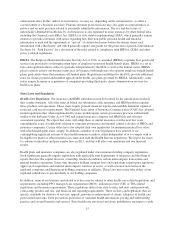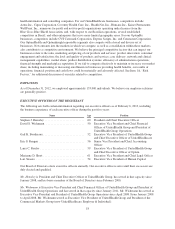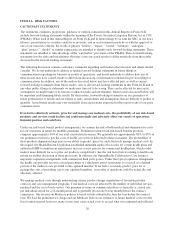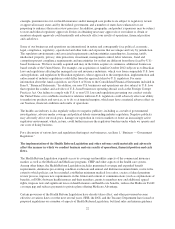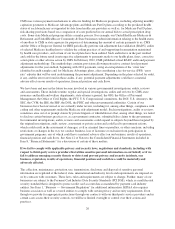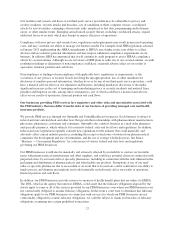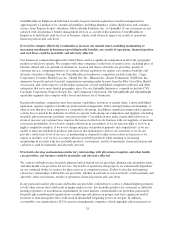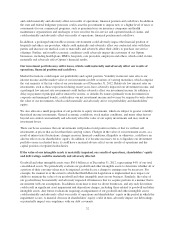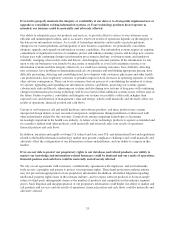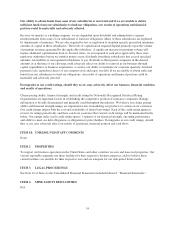United Healthcare 2012 Annual Report Download - page 26
Download and view the complete annual report
Please find page 26 of the 2012 United Healthcare annual report below. You can navigate through the pages in the report by either clicking on the pages listed below, or by using the keyword search tool below to find specific information within the annual report.Several of the provisions in the Health Reform Legislation will likely increase our medical cost trends. Examples
of these provisions are the excise tax on medical devices, annual fees on prescription drug manufacturers,
enhanced coverage requirements (including essential health benefit requirements and phased-in closing of the
coverage gap for Medicare Part D participants), the prohibition of pre-existing condition exclusions and the
implementation of adjusted community rating requirements. The annual insurance industry assessment ($8
billion to be levied on the insurance industry in 2014 increasing to $14.3 billion by 2018 with increasing annual
amounts thereafter), which is not deductible for income tax purposes, and the temporary reinsurer’s fee ($25
billion to be levied on all commercial lines of business including insured and self-funded arrangements, over a
three-year period starting in 2014), will increase our operating costs. Premium increases or benefit reductions
will be necessary to offset the impact these and other provisions will have on our medical and operating costs.
These premium increases are often subject to state regulatory approval, and the Federal government is
encouraging states to intensify their reviews of requests for rate increases by commercial health plans and
providing funding to assist in those state-level reviews. We have begun to experience greater regulatory
challenges to appropriate premium rate increases in several states, including California and New York. In
addition, as required under the Health Reform Legislation, HHS established a federal premium rate review
process, which became effective in September 2011 and generally applies to proposed rate increases equal to or
exceeding 10%. The regulations further require commercial health plans in the individual and small group
markets to provide to the states and HHS extensive information supporting rate increases. If we are not able to
secure approval for adequate premium increases to offset increases in our cost structure or if consumers forego
coverage as a result of such premium increases, our margins, results of operations, financial position and cash
flows could be materially and adversely affected. In addition, plans deemed to have a history of “unreasonable”
rate increases may be prohibited from participating in the state-based exchanges that become active under the
Health Reform Legislation in 2014. Under the regulations, the HHS rate review process would apply only to
health plans in the individual and small group markets.
We also expect that implementation of the Health Reform Legislation will increase the demand for products and
capabilities offered by our Optum businesses. We have made and will continue to make strategic decisions and
investments based, in part, on these assumptions, and our results of operations, financial position and cash flows
could be materially and adversely affected if fewer individuals gain coverage under the Health Reform
Legislation than we expect or we are unable to attract these new individuals to our UnitedHealthcare offerings, or
if the demand for our Optum businesses does not increase.
Future regulatory or legislative action could further impact the implementation of Health Reform Legislation. For
example, Congress may attempt to amend or withhold the funding necessary to implement the Health Reform
Legislation. In addition, a number of state legislatures have enacted or are contemplating significant reforms of
their health insurance markets, either independent of or to comply with or be eligible for grants or other
incentives in connection with the Health Reform Legislation. New federal or state laws and regulations could
force us to materially change how we do business and any amendment, withholding of funding, extended delays
in the issuance of necessary federal and state implementing regulations or guidance or other uncertainty
regarding the Health Reform Legislation could materially and adversely impact our ability to capitalize on the
opportunities presented by the legislation or cause us to incur additional costs of compliance or reverse some of
the changes we have already implemented. In addition, our market share, our results of operations, our financial
position, including our ability to maintain the value of our goodwill, and our cash flows could be materially and
adversely affected by legislative and regulatory changes.
For additional information regarding the Health Reform Legislation, see Item 1, “Business — Government
Regulation” and Item 7, “Management’s Discussion and Analysis of Financial Condition and Results of
Operations — Executive Overview — Regulatory Trends and Uncertainties.”
24



